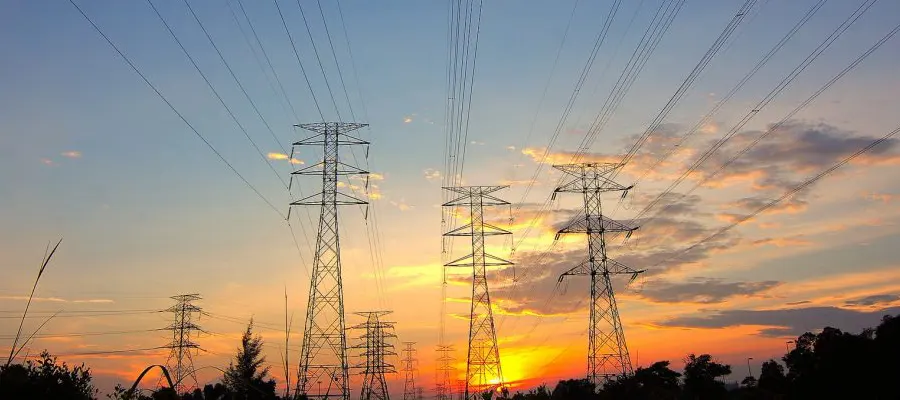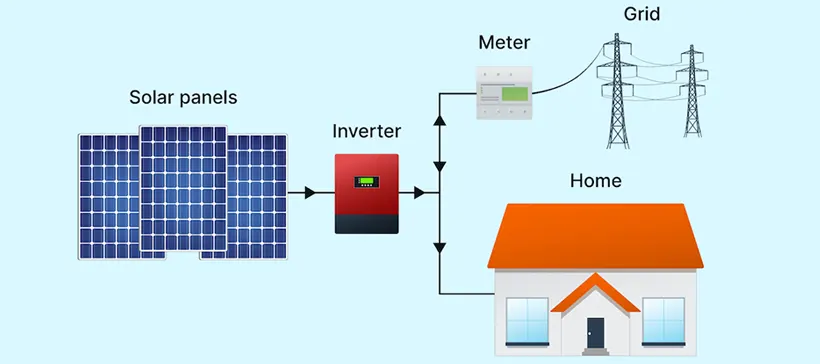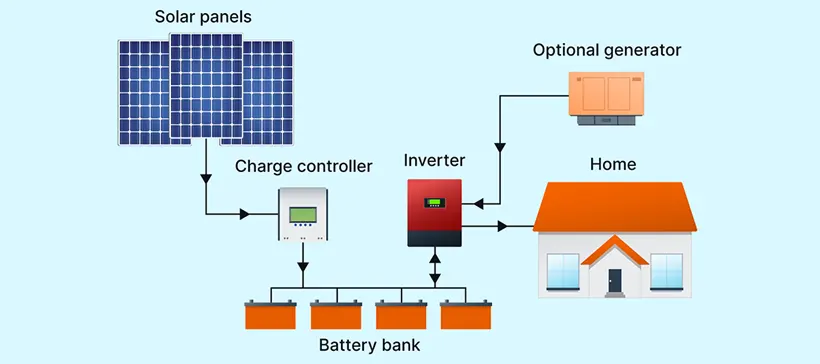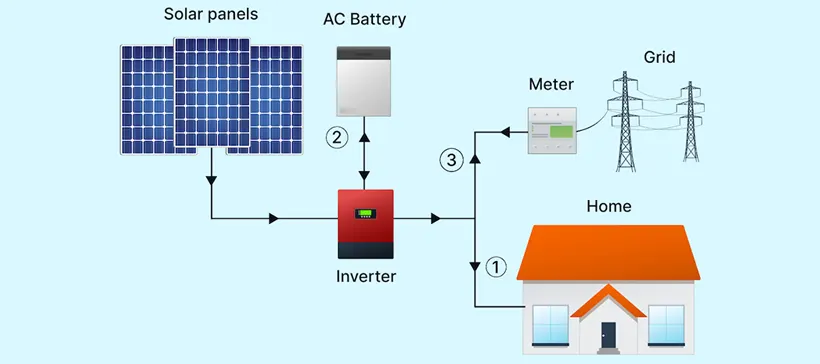- HOME
- ABOUT US
- SOLUTIONS
- Metal Roof PV Mounts and Systems
- Flat Roof Solar Panel Mounting Systems Solutions
- Tile Roof Solar Mounting Systems Solutions
- Solar Tracking Solutions for Commercial PV Projects
- Ground Solar Mounting Systems Solutions
- Floating Solar Solutions - PV Systems
- PV Solar Carport Mounting Systems Solutions
- Balcony Solar Panel Mounting Systems Solutions
- PRODUCTS
- PROJECTS
- COMPANY NEWS
- BLOG
- Contact Us

Many people are turning to solar energy these days, owing to its low cost, durability, dependability, and environmental friendliness. If you're thinking about going solar, you'll need to choose between three types of systems: off-grid, grid-tied, and hybrid. Choosing the right system means lowering your energy costs and getting a good return on your investment in the long run.
If you work with a reputable solar installer, they will be able to guide you through these decisions in order to get you the best system for your needs. However, doing some preliminary research can't hurt either. This guide will make the process easier by explaining the three types of solar systems, their benefits and drawbacks, and the differences between them.
The Three Main Types of Solar Power Systems
Your solar system can function in one of three ways: connected to the grid, independent of the grid, or a combination of both. As a result, there are three types of systems:
1. On-grid System

The power generated by the solar panels is sent to the inverter, which converts it to alternating current (AC). This electricity is first used to power home loads, and any excess energy is exported to the grid in exchange for electric bill credits.
By far the most common and widely used solar systems in homes and businesses. These systems are connected to the public electricity grid, do not require batteries, and use standard solar inverters. Any excess solar power generated is exported to the grid, and you are usually compensated with a feed-in-tariff (FiT) or credits for the energy you export.
On-grid solar systems, unlike hybrid systems, cannot function or generate electricity during a blackout for safety reasons. Because blackouts typically occur when the electricity grid is damaged, if the solar inverter continued to feed electricity into a damaged grid, it would jeopardize the safety of those repairing the network fault/s. Most hybrid solar systems with battery storage can automatically disconnect from the grid (a process known as islanding) and continue to supply some power during a power outage.
Pros:
● Lower initial costs and ease of installation.
● It is less expensive because it does not require a battery backup system.
● Excess solar energy is not wasted; it is sold to the electric company.
● On cloudy or low-generation days, the grid can provide power.
Cons:
● Incapable of storing electricity.
● Will not provide electricity at night.
● Does not function during power outages because it is powered by the power grid.
2. Off-grid System

Because there is no way to import power from the grid, off-grid systems necessitate extensive energy storage. As a result, they are typically designed with lead-acid batteries, which are significantly less expensive than newer (and more efficient) lithium-based solar batteries.
Because an off-grid system is not connected to the power grid, battery storage is required. An off-grid solar system must be properly designed to generate enough power throughout the year and have enough battery capacity to meet the home's needs, even in the dead of winter when there is little sunlight.
Off-grid systems are much more expensive than on-grid systems due to the high cost of batteries and inverters, and are usually only required in more remote areas that are far from the electricity grid. However, as battery prices continue to fall, there is now a growing market for off-grid solar battery systems, even in cities and towns.
Pros:
● Can be installed in areas without access to the utility grid.
● Provides consumers with complete self-sufficiency in energy production.
● Allows for the storage of electricity for use at night.
● Prevents power outages and grid failures.
Cons:
● Due to the recurring cost of batteries, off-grid systems are more expensive than on-grid systems.
● Batteries don't last long, are big, and aren't good for the environment.
● Allows for the waste of excess energy.
● When the power generated by the panels is insufficient, the system becomes inoperable.
3. Hybrid System

The energy generated by the solar panels is first used to power the home's electrical loads (flow #1) in a hybrid solar system. Solar power is used to charge the solar battery after the home's energy needs have been met (flow #2). If there is still excess solar energy, it will be exported to the grid in exchange for credits (flow #3). The system shown above uses an AC-coupled lithium battery, but hybrid systems can use either lithium or lead-acid-based DC batteries.
Modern hybrid systems combine solar and battery storage into one unit and are now available in a variety of shapes and sizes. Because the cost of battery storage is decreasing, systems that are already connected to the power grid can begin to benefit from battery storage as well. This entails storing solar energy generated during the day and using it at night. When the stored energy runs out, consumers can use the grid as a backup. This lets them get the best of both worlds. Hybrid systems can also charge batteries with cheap off-peak electricity (usually after midnight to 6 am).
Pros:
● It is outfitted with load management technology.
● Stores electricity to provide continuous power supply.
● Excess energy is not wasted because it is returned to the grid.
Cons:
● Due to the combined cost of the hybrid inverter and solar battery, hybrid PV systems are relatively expensive.
● It requires proper battery handling and maintenance.
● Hybrid solar systems have a shorter battery life, ranging from 7 to 14 years.
● Increase the time it takes to break even.
On-Grid vs. Off-Grid vs. Hybrid
We have summarized some of the key differences between on-grid, off-grid, and hybrid solar systems.
1. Basic Definition
● On-grid solar systems, also known as grid-tied systems, work with the local power grid and send excess energy back to the grid when your solar system is producing more energy than you need.
● Off-grid solar systems, also known as standalone systems, do not connect to the local power grid and instead rely on energy storage in batteries.
● Hybrid solar systems, as the name suggests, combine aspects of both on-grid and off-grid systems by offering the ability to draw power from both the utility grid and energy storage batteries.
2. Energy Independence
● On-grid solar systems do not offer energy independence as they are still reliant on the utility grid. If there is an outage, you will not have access to electricity.
● Off-grid solar systems offer full energy independence, as they do not rely on the utility grid for power. However, it is important to size your system correctly to ensure you have enough energy storage to last during periods of low solar production.
● Hybrid solar systems offer partial energy independence as they can function off-grid when necessary but can also draw power from the grid when additional energy is required.
3. Cost
● On-grid solar systems are typically the most cost-effective option as they do not require expensive energy storage batteries. Additionally, you can offset your energy costs by selling excess energy back to the grid.
● Off-grid solar systems are the most expensive option as they require large energy storage batteries to ensure you have enough power during periods of low solar production. Additionally, these batteries will need to be replaced over time.
● Hybrid solar systems fall somewhere in the middle and can be more cost-effective than an off-grid system since they do not require as many energy storage batteries while still offering energy independence when necessary.
4. Maintenance
● On-grid solar systems require very little maintenance beyond occasional cleaning.
● Off-grid solar systems require more maintenance as energy storage batteries must be checked and replaced when necessary.
● Hybrid solar systems require more maintenance than on-grid systems but less than off-grid systems since they still have energy storage batteries that require maintenance.
5. Ideal Location
● On-grid solar systems are ideal in areas with reliable access to the utility grid and net metering policies that allow you to sell excess energy back to the grid.
● Off-grid solar systems are ideal in remote locations where access to the utility grid is unavailable or prohibitively expensive.
● Hybrid solar systems are ideal in areas with unreliable access to the utility grid or frequent power outages.
Final Thoughts
Both on-grid, off-grid, and hybrid systems are excellent ways to go solar, but the best option depends on your specific situation. Clearly, there are numerous details to consider… which can be overwhelming when you're busy building your dream home.
To make things easier, consult with a solar expert who can guide you through all of the issues. It's the most efficient way to determine whether on-grid, off-grid, or hybrid solar is the best option for you. Contact us to find out more about our solar system solutions.

